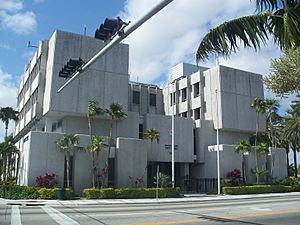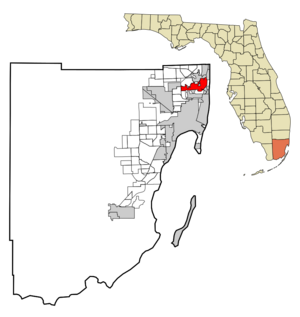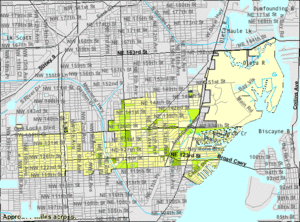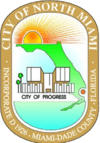North Miami, Florida facts for kids
Quick facts for kids
North Miami, Florida
|
||
|---|---|---|

City Hall
|
||
|
||
| Nickname(s):
NoMi
|
||
| Motto(s):
City of Progress
|
||

Location in Miami-Dade County and the state of Florida
|
||

U.S. Census Bureau map showing city limits
|
||
| Country | ||
| State | ||
| County | ||
| Settled | 1890 | |
| Incorporated (town) | February 1, 1926 | |
| Incorporated (city) | May 27, 1953 | |
| Government | ||
| • Type | Council-Manager | |
| Area | ||
| • Total | 10.05 sq mi (26.03 km2) | |
| • Land | 8.46 sq mi (21.91 km2) | |
| • Water | 1.59 sq mi (4.12 km2) 15.32% | |
| Elevation | 7 ft (3.96 m) | |
| Highest elevation | 42 ft (13 m) | |
| Population
(2020)
|
||
| • Total | 60,191 | |
| • Density | 5,989.2/sq mi (2,312.4/km2) | |
| Time zone | UTC−05:00 (EST) | |
| • Summer (DST) | UTC−04:00 (EDT) | |
| ZIP Codes |
33161, 33167, 33168, 33181, 33160 (North Miami Beach)
|
|
| Area code(s) | 305, 786, 645 | |
| FIPS code | 12-49450 | |
| GNIS feature ID | 0287837 | |
North Miami is a city in Miami-Dade County, Florida, United States. It is located about 10 miles (16 km) north of Miami. The city sits on Biscayne Bay. It is also home to the Biscayne Bay Campus of Florida International University.
North Miami was first called "Town of Arch Creek". Later, it became the "Town of Miami Shores". In 1931, its name changed to the "Town of North Miami". It officially became a city in 1953. North Miami is part of the larger Miami metropolitan area in South Florida.
The city is also home to the Oleta River State Park. This is the largest urban park in the state of Florida. As of 2020[update], North Miami had a population of 60,191 people. It is the seventh largest city in Miami-Dade County.
Contents
History of North Miami
Early Days and Arch Creek
In 1856, soldiers from the United States Army created a trail. This trail connected Fort Lauderdale to Fort Dallas in Miami. It crossed a special natural limestone bridge. This bridge was 40 feet (12 m) long over a creek. This area became known as "Arch Creek".
Before 1890, a few brave pioneers lived near the Arch Creek Natural Bridge. This bridge was a very old Native American settlement site. In 1891, Mr. Ilhe was the first person to settle there. He bought 80 acres (32 ha) of land from the state of Florida. He paid one dollar per acre. He built a simple shelter and grew many different crops.
By 1905, the area around the Arch Creek Railroad Depot became the center of the community. A post office and a school opened there. By 1912, there were 18 homes, a church, a general store, and two tomato packing houses. Farming was the main job for the people living there.
Becoming the Town of Miami Shores
The Florida land boom brought changes to Arch Creek. In 1924, the Biscayne Canal was dug. This helped drain the land, but it also made farming less profitable. The drained land was then sold for development.
On February 5, 1926, the community voted to become a town. It was named the "Town of Miami Shores". This name was chosen because its eastern border reached the Atlantic Ocean. The town's leaders decided to build streets, sidewalks, a town hall, and a water system.
A big hurricane in September 1926 stopped the land boom. The community recovered, but land sales slowed down. In 1928, a Spanish-Mediterranean style city hall was built. It also housed the police and fire departments.
Renamed North Miami
In 1931, a part of the town along the Atlantic oceanfront separated. This was because they were not receiving town services. The Florida Legislature then officially changed the name of the "Town of Miami Shores". The local people chose a new name: the "Town of North Miami".
During the Great Depression, in 1933, two women were elected to the Town Council. They were Mrs. Cecille Sevier and Mrs. Ella S. Klefeker. By 1940, North Miami had 1,973 residents.
Growth After World War II
After World War II in 1945, many military veterans and their families moved to North Miami. This led to a huge growth period. New homes, roads, shops, and offices were built for many years. By 1951, North Miami was one of the fastest-growing towns in the United States.
To handle this fast growth, North Miami voters decided to adopt a new plan in 1952. On May 27, 1953, the town officially became the "City of North Miami". This new plan created a full-time City Manager to run the city. In 1951, construction began for North Miami High School, which opened in 1954.
North Miami is known for its large Haitian-American population. In 2001, Josaphat Celestin became the first Haitian American mayor of a large city in Miami-Dade County. Later, Andre Pierre, Lucie Tondreau, Dr. Smith Joseph, and Philippe Bien-Aime, all of Haitian background, also served as mayor.
Geography
North Miami is located at 25°53′42″N 80°11′09″W / 25.895022°N 80.185747°W.
The city covers about 10.0 square miles (26.0 km2). About 8.5 square miles (22.0 km2) is land, and 1.5 square miles (3.9 km2) is water. This means about 15.32% of the city is water.
Climate in North Miami
North Miami has a tropical monsoon climate. This means summers are very hot and long. Nights are warm, and there is a lot of rain. Winters are short, warm, and dry.
| Climate data for North Miami | |||||||||||||
|---|---|---|---|---|---|---|---|---|---|---|---|---|---|
| Month | Jan | Feb | Mar | Apr | May | Jun | Jul | Aug | Sep | Oct | Nov | Dec | Year |
| Mean daily maximum °F (°C) | 75 (24) |
77 (25) |
81 (27) |
84 (29) |
88 (31) |
90 (32) |
92 (33) |
92 (33) |
91 (33) |
87 (31) |
83 (28) |
78 (26) |
85 (29) |
| Mean daily minimum °F (°C) | 62 (17) |
64 (18) |
68 (20) |
70 (21) |
74 (23) |
79 (26) |
78 (26) |
78 (26) |
78 (26) |
74 (23) |
70 (21) |
65 (18) |
72 (22) |
| Average precipitation inches (mm) | 2.34 (59) |
2.22 (56) |
3.20 (81) |
3.90 (99) |
6.08 (154) |
10.24 (260) |
7.00 (178) |
9.20 (234) |
8.88 (226) |
6.56 (167) |
3.83 (97) |
2.59 (66) |
66.04 (1,677) |
Neighboring Areas
- Golden Glades, North Miami Beach
- Opa-locka


 Sunny Isles Beach
Sunny Isles Beach - Westview

 Sunny Isles Beach, Biscayne Bay, Bay Harbor Islands
Sunny Isles Beach, Biscayne Bay, Bay Harbor Islands - Westview


 Biscayne Bay
Biscayne Bay - Pinewood, Unincorporated Miami-Dade County, Biscayne Park
Population and People
| Historical population | |||
|---|---|---|---|
| Census | Pop. | %± | |
| 1940 | 1,973 | — | |
| 1950 | 10,734 | 444.0% | |
| 1960 | 28,708 | 167.4% | |
| 1970 | 34,767 | 21.1% | |
| 1980 | 42,566 | 22.4% | |
| 1990 | 49,998 | 17.5% | |
| 2000 | 59,880 | 19.8% | |
| 2010 | 58,786 | −1.8% | |
| 2020 | 60,191 | 2.4% | |
| U.S. Decennial Census | |||
North Miami is a diverse city. The table below shows the different racial and ethnic groups living there. Hispanic/Latino is an ethnic group, and people of any race can be Hispanic/Latino.
| Race / Ethnicity (NH = Non-Hispanic) | Pop 2000 | Pop 2010 | Pop 2020 | % 2000 | % 2010 | % 2020 |
|---|---|---|---|---|---|---|
| White alone (NH) | 10,860 | 7,287 | 6,513 | 18.14% | 12.40% | 10.82% |
| Black or African American alone (NH) | 31,758 | 33,243 | 30,397 | 53.04% | 56.55% | 50.50% |
| Native American or Alaska Native alone (NH) | 123 | 123 | 77 | 0.21% | 0.21% | 0.13% |
| Asian alone (NH) | 1,130 | 950 | 907 | 1.89% | 1.62% | 1.51% |
| Pacific Islander or Native Hawaiian alone (NH) | 23 | 22 | 4 | 0.04% | 0.04% | 0.01% |
| Other race alone (NH) | 132 | 162 | 496 | 0.22% | 0.28% | 0.82% |
| Mixed race or Multiracial (NH) | 1,985 | 1,040 | 1,449 | 3.31% | 1.77% | 2.41% |
| Hispanic or Latino (any race) | 13,869 | 15,959 | 20,348 | 23.16% | 27.15% | 33.81% |
| Total | 59,880 | 58,786 | 60,191 | 100.00% | 100.00% | 100.00% |
As of 2020[update], there were 60,191 people living in North Miami. There were 19,529 households and 12,828 families.
As of 2011[update], many Haitian American people live in North Miami. Many moved there from other parts of Miami.
Economy
Yogen Früz, a frozen yogurt company, has its East Coast offices in North Miami.
Transportation
In 2004, North Miami started a free community bus service called the NoMi Express. This bus helps people get around the city. It carries about 16,000 riders each month. The larger Metrobus system also serves North Miami.
Fun Places to Visit
Museums
- The Museum of Contemporary Art (MOCA) is an art museum in downtown North Miami. It is 23,000 square feet (2,137 m2) in size. The building was designed by famous architect Charles Gwathmey.
- The Miami Auto Museum shows a large collection of cars. These include classic cars, Hollywood cars, mini cars, scooters, motorcycles, and bicycles. They are all from the collection of Michael Dezer.
State Parks
- The Oleta River State Park is the biggest urban park in Florida's state park system. It covers 1,043 acres (422 ha). Most of it is land, and 50 acres (20 ha) is water. The park is on Biscayne Bay. It is next to the Biscayne Bay Campus of Florida International University.
- The Arch Creek Park opened in 1982. It is an 8-acre (3.2 ha) site in North Miami. It is a great place to study plants, history, and archaeology. The park has a museum and nature center. It shows Native American tools found there. You can also see live animals. It is the only protected archaeological site in the county.
Chinatown
Chinatown is a 90-acre (36 ha) area in North Miami. It is being redeveloped to celebrate Chinese culture. As of 2019, it was still being built.
Biscayne Landing Development
Biscayne Landing is a large new community. It will have shops, hotels, and homes. It is being built on the site of a former landfill. The city of North Miami still owns the land. Developers have a long-term lease to build the project.
The plan for Biscayne Landing includes about 120,000 square feet (11,148 m2) of shops and offices. It will also have between 2,800 and 5,000 homes. There will be a park and places for recreation. The developers have also promised to fix up the city's library. They will also build a school, an Olympic training center, and affordable housing. The project is expected to be finished by 2021.
Part of Biscayne Landing includes wetlands near Biscayne Bay. These wetlands will be saved as a 35-acre (14 ha) environmental park. This park will have nature trails, jogging paths, and information about local wildlife. It will also connect to Oleta River State Park.
In 2009, the project faced problems because of a slowdown in real estate. Most of the homes built were empty. Later, new developers bought the site. They are now building a new project called SoleMia. This will be a very large development.
Education
Schools in North Miami
Miami-Dade County Public Schools serves the students in North Miami.
Elementary Schools
- Benjamin Franklin Elementary School
- Biscayne Gardens Elementary School
- Gratigny Elementary
- North Miami Elementary School
- Natural Bridge Elementary School
- W. J. Bryan Elementary School
Middle Schools
- Thomas Jefferson Middle School
- North Miami Middle School
K–8 Centers
High Schools
- Alonzo and Tracy Mourning Senior High Biscayne Bay Campus
- North Miami Senior High School
- MAST@FIU BBC
Private Schools
- Northwest Christian Academy
- Holy Cross Lutheran School
- Yeshiva Toras Chaim
- Miami Union Academy SDA
- Montessori School of North Miami
- Get Smart Kids Academy
Colleges and Universities
- Florida International University (Biscayne Bay Campus)
Public Library
The North Miami public library is the city's library. Unlike many other city libraries in the county, it has stayed independent.
The library first opened in 1932. It was located in the City of North Miami's town hall. It was closed during World War II. In 1945, it reopened in the same place. In 1948, the library became a free public library. Today, the library is being renovated to make it even better for the community.
Key to the City Recipients
The "Key to the City" is a special honor given by North Miami. Here are some people who have received it:
- 2012 Kim and Kourtney Kardashian
- 2013 Gregory Toussaint (Pastor)
- 2018 Eduardo Padron (President of Miami Dade College)
See also
 In Spanish: North Miami para niños
In Spanish: North Miami para niños



